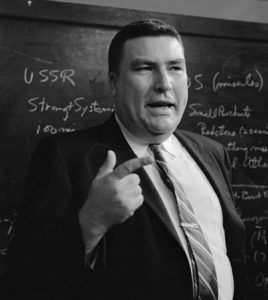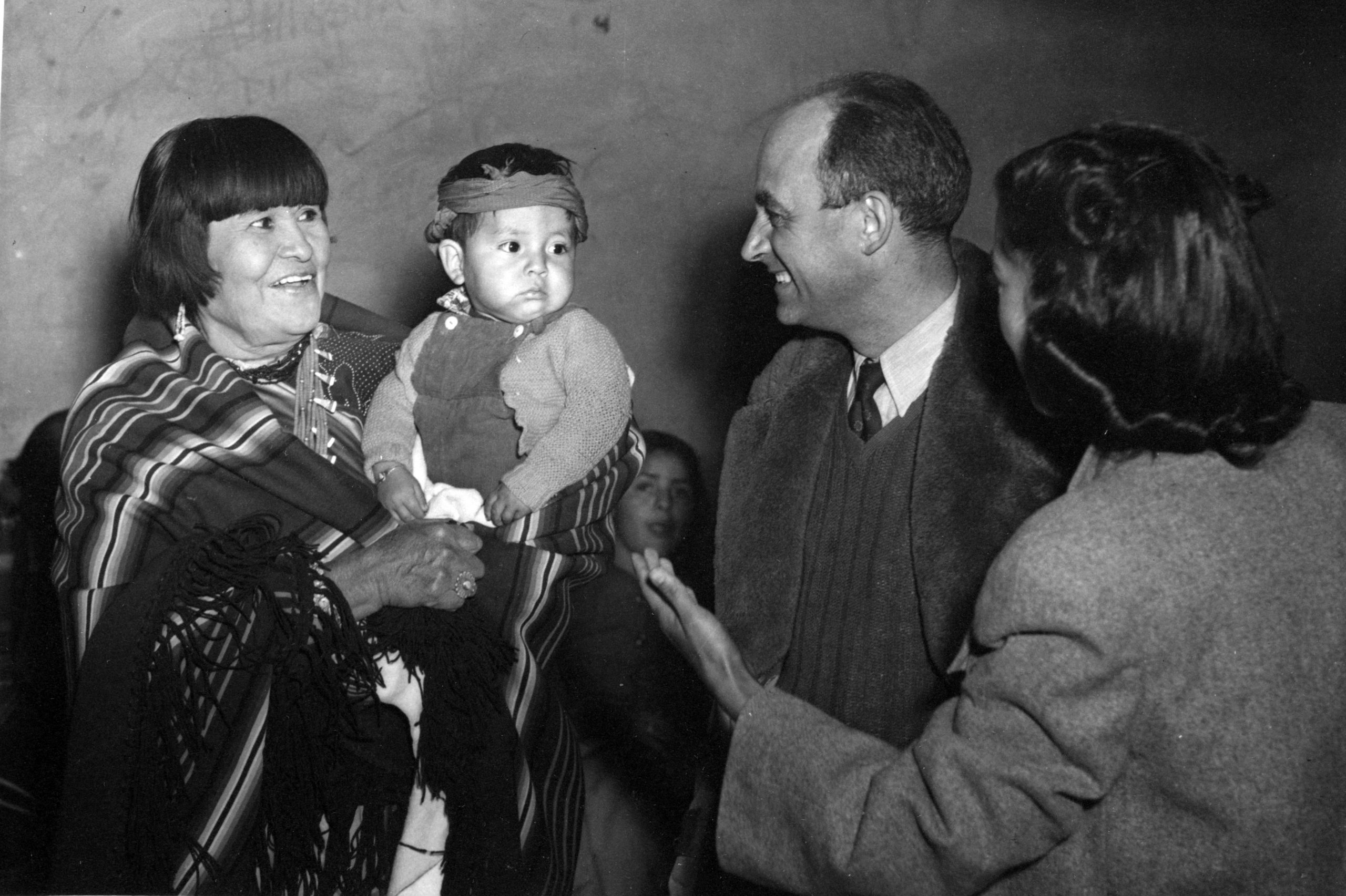Native Americans throughout the United States performed important wartime service. Roughly ten percent of the country’s Native American population served in the military, nearly one third of all able-bodied men. Nez Perce tribal elder Veronica Taylor recalls, “My dad had to go away to military training and go into the war. It was the same way with a lot of the other families.” Separation from family and tradition would be a recurring theme for Native Americans during the war. For many Native Americans living near the lands taken over for the Manhattan Project, World War II was especially disruptive, with long-term cultural, economic and environmental impacts.
The Manhattan Project prohibited many Native Americans from enjoying their ancestral lands as the military took over hundreds of square miles for scientific laboratories and industrial production facilities at Los Alamos, NM and Hanford, WA. While Manhattan Project officials made some provisions for access, Native Americans were generally unable to enjoy their traditional hunting, fishing and camping grounds or sacred ancestral sites. With little warning, the Manhattan Project abruptly disrupted Native Americans’ traditional ways of life. Afterwards, decades of environmental contamination further eroded Native Americans’ former lands and traditional lifeways.
Hanford, WA .jpg)
Native American tribes were the earliest known inhabitants of the Columbia Basin. The area was known for its excellent salmon fishing. The Wanapum was the only tribe to settle in the Hanford area, while the Nez Perce, Yakama and Umatilla relied on the Columbia Basin for hunting, fishing, and ceremonial purposes. Today artifacts associated with the campsites or burial grounds can be found on the Hanford site.
On January 13, 1943, General Leslie Groves officially selected the Hanford area as the Manhattan Project’s plutonium production site. Local residents were given ninety days to relocate. Construction on the world’s first nuclear reactor, the B Reactor, began in June.
White residents of towns like Hanford and White Bluffs were offered minimal compensation for their property. However, local Native American tribes, including the Confederated Tribes of the Umatilla, Yakama, and Nez Perce, were given no such recourse. Instead, they were not allowed on lands where they had camped, hunted, and fished for centuries.
These three Hanford tribes are mobile people who at one point inhabited large tracts of land between Montana and Oregon, including parts of the Hanford site. Within the site, the area along the Columbia River was a longtime fishing site for several tribes. Yakama tribe member Russell Jim recalls the idyllic conditions of the Hanford site before the Manhattan Project, when it served as the Yakama wintering ground. “We lived in harmony with the area, with the river, with all of the environment. All the natural foods and medicines were quite abundant here.” Taylor has a similar recollection. “It was kind of like a farmer’s market, where people came and traded goods and materials and foods with each other,” she reminisces.
The Native American communities expressed confusion and outrage at the announcement that they were no longer allowed to visit this ancestral land. Rex Buck, Jr. is a member of the Wanapum tribe and a descendant of people who were displaced. He notes, “They didn’t know what to think or what to feel, because they didn’t understand why they were going to have to leave.” That confusion was no doubt driven by vagueness about the nature of the project. Buck’s elders were told, “This would be just for the war, that in order to protect the United States of America, they were going to do something here.” And so, with little more explanation, work at Hanford commenced, with the indigenous people relocated to Priest Rapids, nearly forty miles northwest.
It should be noted that Native Americans were given some access to their lands. Colonel Franklin Matthias, the Officer-in-Charge at Hanford, recalled a meeting with Wanapum Chief Johnny Buck where he granted the tribe daily visitation rights to the Hanford area: “I’ll arrange to take your people up to the White Bluffs Island every morning by truck and you can do your fishing, and bring you back by night.” In this way, some indigenous people were granted some access to their homeland. However, such efforts were not enough to prevent bitter feelings.
Today, the nine reactors lining the Columbia River are no longer used to produce power or plutonium, but the site generally remains off limits to the public. While tourists are allowed to visit the B Reactor, at this time they must sign up ahead of time and remain with their tour group. The National Park Service and Department of Energy are beginning to consider greater public access to the Manhattan Project sites that will be interpreted as part of the Manhattan Project National Historical Park.
Native Americans continue to mourn the lack of access to the site and express concern over the effectiveness of the environmental cleanup at Hanford. “The area was an isolated wasteland, and the people were expendable,” mourns Jim. “The Yakama people and many others are suffering the consequences health-wise.”
Gabriel Bohnee is a member of the Nez Perce tribe who works for the tribe’s Environmental Restoration and Waste Management Office. He asserts, “The environment was sacrificed in the name of global power.”
Taylor also describes the permanence of the removal from indigenous territory. She laments that even today, many Nez Perce “don’t want to come over here and dig roots anymore because of the ground, what has happened to the ground.”
Los Alamos, NM
The Los Alamos project site was home to the top-secret Project Y, led by J. Robert Oppenheimer. It was the hub of the Manhattan Project and home to numerous high-stakes experiments conducted by a large team of scientists, engineers, and support staff.
The Los Alamos area was also home to several Pueblo communities. The Pueblos trace their heritage to the Ancestral Pueblo people, whose civilization began in 1200 BC and eventually extended over much of the Southwest. The San Ildefonso Pueblo was the nearest to the project site. Its community was small and steeped in tradition. Many of its residents were avid potters, a cultural art that had been practiced there for millennia. The arrival of the Manhattan Project in Los Alamos in 1943 was believed to be a temporary “interference” by outsiders into northern New Mexico. Instead, the “lab on the Hill” has become a permanent reality for the region.
During the Manhattan Project, Los Alamos had a significant need for maintenance and custodial workers. Its isolation allowed ample space for experimentation, but it also left few options for local employees. As a result, many Native American people were hired from the nearby San Ildefonso Pueblo. Men were generally employed as truck drivers, construction and maintenance workers, carpenters, and gardeners. Women were recruited as maids and child-care providers.
The site eventually came to rely on their contributions. Ellen Bradbury Reid spent part of her childhood at Los Alamos while her father worked in the high explosives division. She remembers, “The whole lab would close on January 23rd, San Ildefonso Day, because you could not get enough maintenance workers to run the lab.” Many Pueblo women were lured by higher wages and worked as maids in Los Alamos. Reid had positive memories of the interactions between Native Americans and scientists at Los Alamos, recalling, “People at Los Alamos appreciated that culture because it was so different.”
Historian Peter Bacon Hales argues that the Pueblo natives “became exotic. Their differences made them objects of romance in the scientific community.” A “collector’s mania” within the Los Alamos community made the pottery of people like Maria Montoya Martinez in great demand. A maternal figure within her community, Maria was a very talented potter who would become world-renowned in the years following the war. During the war, employees of the Manhattan Project were awed by her work and flocked to collect as much indigenous cultural art as possible. That fascination led to square dances, holiday feasts and other cultural exchanges between the two groups.
The Los Alamos community was fascinated with the Pueblo culture and their artwork in particular. However, their demands destabilized the traditional patterns of the Pueblo communities. To keep up with the demand for pottery, potters began to mass produce their wares for sale, undoing centuries-long traditions of making items one at a time for special occasions.
There are few public narratives describing the perspectives of Native Americans living near Los Alamos during the Manhattan Project. Most accounts come from scientists and their families who were living there. That conversation’s one-sidedness reflects the stratification of the relationship, despite its seemingly friendly nature.
Oak Ridge, TN
There are scant records of any Native Americans at the Manhattan Project’s uranium enrichment plants in Oak Ridge, Tennessee. Helen Jernigan, who lived and worked in the community during the war, offers one of the few accounts of their presence. She describes a small but dedicated population, recalling, “They mostly just romped through there in their blue jeans like everybody else. But they stood out because of their appearance and because of their friendliness. They were very friendly.”
Oak Ridge also hosted the only known Native American scientist to work on the Manhattan Project. Herbert York was a part-Mohawk physicist who worked on the electromagnetic separation of uranium-235 at the Y-12 Plant. York would go on to receive a Ph.D. from the University of California, Berkeley, and served as the first director of the Lawrence Livermore National Laboratory.
The Legacy of the Manhattan Project
The legacy of the Manhattan Project for Native Americans was decidedly mixed. For some, the Manhattan Project brought greater economic prosperity. The government offered paying jobs and introduced a cash economy. While the jobs available were low-level, they offered an alternative to subsistence farming and the potential for advancement. For many others, the displacement from the lands, threat to the environment and disruption of their culture were overwhelmingly negative. Many Native Americans continue to grapple with anxiety about the long-term impact of the Manhattan Project on their health and environment.
The Manhattan Project National Historical Park will interpret the displacement of Native Americans as part of its programs. This story of cross-cultural interaction is important in appreciating more fully the impact of the Manhattan Project on Native Americans and its continuing legacy.





